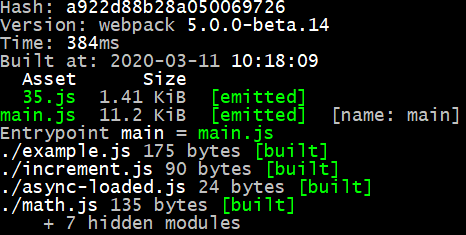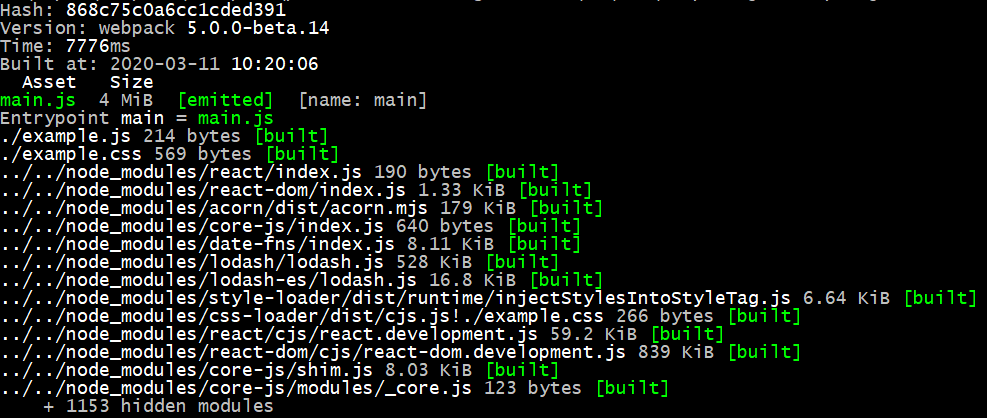Feedback on the webpack 5 stats output
See original GitHub issueIn this issue I want to collect feedback on the state output for webpack. For webpack 5 we have the change the improve the default output. For webpack 5 the Stats internally has been refactored to extensibility, but the output has kept as it was in webpack 4 (expect for some minor changes).
Please leave any feedback you like. Here are some question to inspire you:
- What information is important for you?
- Regarding the default output: What pieces of the output did you enable with the
statsoption?
- Regarding the default output: What pieces of the output did you enable with the
- What information distracts you and is unneeded?
- Regarding the default output: What pieces of the output did you disable with the
statsoption?
- Regarding the default output: What pieces of the output did you disable with the
- How can information shown in a better way?
- Readablility?
- More useful format?
- Missing aspects?
- Color and highlighting?
- Maybe paste a screenshot of your output
- Do you use a custom tool for displaying webpack results?
Here are some examples of stats output:
Small build:

Small build with many node_modules:

Large build:


Incremental build in watch mode:

Here is my own feedback:
- node_modules in the stats is not as useful.
- The assets table doesn’t scale well for many assets or long asset names
- Hash seem to be useless
- Version, Time and Build at could be displayed in a more condensed way, in a single line, headers can be omitted
- There is no success/failure summary. Best this would be at the end of the output.
- Sizes of modules are not as useful as it doesn’t include sizes of dependencies.
- KiB vs MiB is not really obvious, large assets are easy to miss
- hidden modules/assets may confuse
- In small builds:
[emitted]is useless- Entrypoint is useless when there is only one with a single file
- Asset meta info like
[name: main]is useless - Time is useless
- Module meta info like
[built]and size is useless
- In large builds:
- Long list of files for an Entrypoint is useless
- List of 15 (random?) modules is useless in first build, but useful in incremental build
- Assets list is useless in first build, but useful in incremental build
- All
[dev]assets are useless
Here are some ideas:
- Hide
[dev]assets by default - When assets > 15, group them by extension and flags:
- 14 *.js [emitted] [immutable], 4 *.js [emitted], 13 *.css [emitted] [immutable]
- always show assets which are too large
- Hide Entrypoints by default when 1 entrypoint with 1 file
- Show total size of files in entrypoint
- Summarize entrypoint files when > 5:
Entrypoint main = 7 asset 3.45 MiB (14 auxilary assets 3.45 MiB) - Hide module size by default
- Hide
[built]flag when only build assets are shown - Hide
[emitted]flag when only emitted assets are shown - Show summary of hidden asset/modules
+ 9 hidden asset (3 not emitted assets, 6 dev assets)- `+ 541 hidden modules (500 not built modules, 32 not included modules, 9 runtime modules)
- Display assets in list instead of table, like modules
- remove color from folders in asset name, highlight the extension.
- Instead of hiding modules that doesn’t fit in the limit, group them by folders
- This should automatically group node_modules in a useful way
- Show modules in a tree groups by folder
- show only folder summary when module limit has been reached
- excluded modules will always by show as summary
- Can we do the same for the assets list?
- Should this be done in the JSON too?
./js/
index.js 7.85 KiB [built]
indexedDB.js 1.04 KiB [built]
butterchurnOptions.ts 2.92 KiB [built]
dropboxFilePicker.ts 923 bytes [built]
../node_modules/
raven-js/ 5 modules 838 bytes [built]
react/ 4 modules 190 bytes [built]
react-dom/ 6 modules 1.33 KiB [built]
raven-for-redux/built/ 10 modules 2.22 KiB [built]
butterchurn/lib/isSupported.min.js 1.4 KiB [built]
../skins/base-2.91-png.wsz 104 bytes [built]
../js/
constants.ts 1.33 KiB [built]
selectors.ts 18.4 KiB [built]
actionTypes.ts 4.48 KiB [built]
webampLazy.tsx 9.58 KiB [built]
actionCreators/index.ts 4.15 KiB [built]
Issue Analytics
- State:
- Created 4 years ago
- Reactions:1
- Comments:24 (14 by maintainers)
 Top Results From Across the Web
Top Results From Across the Web
Stats - webpack
It is possible to specify which information you want to see in the stats output. tip. All of the options in the stats...
Read more >Stats Data - webpack
Stats Data. When compiling source code with webpack, users can generate a JSON file containing statistics about modules. These statistics can be used...
Read more >Output - webpack
The top-level output key contains a set of options instructing webpack on how and where it should output your bundles, assets, and anything...
Read more >Webpack 5 release (2020-10-10)
Webpack 5 has now native support for modules representing assets. These modules will either emit a file into the output folder or inject...
Read more >6 Tools and Techniques to Analyze Webpack Bundle Size
In this approach, all you need to do is generate a stat file using webpack — profile — json > webpack-stats.json command and...
Read more > Top Related Medium Post
Top Related Medium Post
No results found
 Top Related StackOverflow Question
Top Related StackOverflow Question
No results found
 Troubleshoot Live Code
Troubleshoot Live Code
Lightrun enables developers to add logs, metrics and snapshots to live code - no restarts or redeploys required.
Start Free Top Related Reddit Thread
Top Related Reddit Thread
No results found
 Top Related Hackernoon Post
Top Related Hackernoon Post
No results found
 Top Related Tweet
Top Related Tweet
No results found
 Top Related Dev.to Post
Top Related Dev.to Post
No results found
 Top Related Hashnode Post
Top Related Hashnode Post
No results found

@erykpiast ?
Yes, I’m talking about this…
For comparison, this is how it used to work before. Sure, not ideal, but better in my opinion: